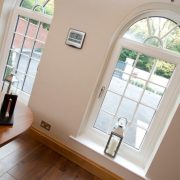Today’s homeowners have more control over indoor comfort than ever, and windows sit at the center of that transformation. Thoughtfully chosen glazing and frames can stabilize interior temperatures, calm outside noise, and refresh a home’s curb appeal—all in one project. Whether you’re planning a single-room update or a whole-home upgrade, aligning materials, performance ratings, and installation practices will determine how well your new windows perform in every season. Partnering with pros who understand building science and design is just as important as choosing the right product line. With an eye on durability and design, brands known for delivering Quality Exteriors help ensure your Window Replacement delivers measurable comfort and energy savings for years to come.
Energy-Efficient Glass Choices for Better Insulation
Modern glazing does more than fill a wall opening; it actively manages heat transfer to keep interiors comfortable year-round. Low-emissivity coatings reflect infrared energy, reducing heat loss in winter and limiting solar heat gain in summer without sacrificing daylight. Double- and triple-pane configurations, combined with argon or krypton gas fills, cut conductive heat flow and help maintain even interior surface temperatures. Warm-edge spacers reduce edge-of-glass condensation risks while improving overall U-factor performance. Together, these components create a balanced system tuned for your climate, orientation, and daylight preferences.
How modern glazing manages heat flow
When comparing options, focus on U-factor for insulation and SHGC (solar heat gain coefficient) for sun control, and remember that lower numbers are generally better for both. In cold climates, a low U-factor paired with a moderate SHGC can capture passive solar heat on south-facing elevations, improving comfort and lowering heating loads. In hot-summer regions, a low SHGC prevents rooms from overheating, reducing cooling demand while preserving clear views. Glass packages can also incorporate spectrally selective coatings that filter heat-carrying wavelengths while letting visible light pass, keeping interiors bright but cooler. The result is a window that feels comfortable to sit beside, even during temperature extremes.
In practice, right-sizing performance is as important as choosing the latest technology, and a thoughtful Window Replacement balances insulation, solar control, and daylight. Consider room-by-room needs: a shaded living room may benefit from a higher SHGC, while a sun-exposed office might require stronger heat rejection to protect finishes and electronics. Don’t overlook condensation resistance ratings and edge-of-glass temperatures, which influence comfort and durability in cold snaps. Local utility rebates and ENERGY STAR certification can offset upfront costs and validate performance, but look beyond stickers to ensure the selected glazing complements your home’s orientation and shading. Investing in a well-specified glass package pays back through steadier indoor temperatures, quieter HVAC cycles, and a noticeably cozier feel near the glass.
Reducing Noise With Updated Window Technologies
Urban bustle, yard equipment, and traffic can chip away at indoor calm, making noise control a high-impact upgrade for many households. Modern windows tackle sound at multiple layers: glass thickness, pane asymmetry, laminated interlayers, and airtight frames all contribute to quieter rooms. Laminated glass, with its PVB or SGP interlayer, dampens vibrations particularly well at speech frequencies and higher-pitched traffic noise. Asymmetric double- or triple-pane units disrupt resonance by using different glass thicknesses, reducing the transmission of a single dominant frequency. Just as critical, robust seals and correct installation prevent airborne leaks that can undermine even the best glass package.
Engineering quiet into everyday living
To interpret performance, look for STC and OITC ratings; higher numbers suggest better sound reduction, with OITC more reflective of traffic and low-frequency noise. While upgrading to laminated glass often brings a noticeable improvement, pairing it with deep, well-gasketed frames and quality weatherstripping multiplies the effect. Warm-edge spacers and decoupled frames can further reduce vibration transfer between panes and the sash or jamb. When budgets are tight, start with the noisiest rooms—primary bedrooms, nurseries, or home offices—and prioritize openings facing traffic. In many cases, strategic upgrades in a few key locations deliver an outsized boost to daily comfort.
Sound control doesn’t need to look utilitarian, and a well-planned Window Replacement can maintain slim sightlines while dialing down decibels. Specify performance glass in styles that match adjacent rooms so the upgrade blends with your home’s aesthetic choices. Pay attention to venting: operable sashes can be quieter when their locking mechanisms pull tightly against compressible gaskets, improving the seal. On the exterior, adding foliage, fences, or strategic hardscape can complement the acoustic performance of new windows, especially for low-frequency rumble that glass is less effective at stopping. Combine these measures and your interior becomes a sanctuary—focused, restful, and more enjoyable at all hours.
Custom Frame Designs That Boost Home Aesthetics
Windows are architectural punctuation, and their frames, profiles, and colors influence how the entire façade reads from the street. Slimmer frames increase visible glass area, inviting more daylight and enhancing scenic views without overpowering the elevation. Color-through materials and factory-applied finishes expand options beyond white or tan, from crisp black to warm earth tones that echo masonry or trim. Thoughtful grille patterns—prairie, colonial, or modern minimalist—can align with your home’s existing lines and period details. The right combination elevates curb appeal while making interiors feel brighter and more refined.
Details that define curb appeal
Custom sizing, mulling strategies, and transom placement can align sightlines across a façade, creating a cohesive rhythm between windows and doors. Sculpted interior profiles mimic historical woodwork, while flush, square-cut edges deliver a clean, contemporary aesthetic. Hardware choices matter, too; low-profile locks and complementary metal finishes reinforce the style language without drawing undue attention. Interior colors that match or contrast trim can either blend seamlessly or highlight the window as a design feature. Subtle upgrades—like color-coordinated spacers and discreet gaskets—avoid visual clutter up close.
A design-led approach doesn’t have to sacrifice performance, and the best solutions blend style with tangible comfort gains championed by Quality Exteriors. Consider frame materials that stay stable as temperatures swing, preserving tight seals and pristine lines over time. Mix fixed and operable units to maintain ventilation without interrupting a carefully composed elevation. Where views are paramount, specify larger fixed panes at eye level and operable windows to the side for airflow, keeping frames thin and sightlines uncluttered. The result is a home that feels curated inside and out, with windows serving both as artful accents and high-functioning barriers against the elements.
Professional Installation to Prevent Drafts and Leaks
Even excellent windows underperform if they’re installed without attention to air and water management. Proper measurement, shimming, and fastening ensure the unit sits plumb and square, preserving smooth operation and long-term seal integrity. Flashing details—sill pan, jamb flashing, and head flashing—must integrate with the wall’s water-resistive barrier to manage bulk water effectively. Air sealing with the right backer rod and sealant geometry addresses movement and prevents premature joint failure. Done well, installation becomes the quiet, invisible hero of year-round comfort.
What meticulous installers do differently
Pros sequence work to manage risk: protect the opening, dry-fit the unit, confirm reveals, then secure with manufacturer-approved fasteners. They set a sloped or pre-formed sill pan to direct incidental moisture outward, not into the wall cavity. Next comes layered flashing—abide by shingle-lap principles—before sealing the interior with low-expansion foam where appropriate, followed by a continuous interior air barrier. Correct joint design matters; too much foam can bow frames, and the wrong sealant can fail under UV or thermal cycling. Quality control might include water testing, verifying drainage paths, and documenting fastening per AAMA and ASTM guidelines.
A professional team reduces callbacks, preserves warranties, and prevents the subtle drafts that erode comfort and drive up energy bills after a Window Replacement. They’ll also tune the balance between exterior and interior seals to manage pressure differentials, ensuring any incidental moisture has a path to drain. When a project spans multiple elevations, pros coordinate timing with siding and roofing crews to keep weather defenses intact. You’ll feel the difference immediately: quieter rooms, steadier temperatures, and windows that glide open and closed with a reassuring seal. This level of care anchors performance upgrades and complements the style-driven choices made elsewhere in the home.
Sustainable Window Materials Gaining Popularity in 2025
Sustainability has moved from a perk to a priority, and window materials now reflect a deeper commitment to durability and environmental stewardship. Fiberglass frames, made from pultruded glass fibers, offer excellent dimensional stability, low thermal expansion, and long service life, which supports lower embodied carbon over decades. Recycled-content aluminum, especially in thermally broken frames, finds favor in modern designs and commercial-grade performance while reducing raw material demands. Engineered wood from responsibly managed forests provides a warm, timeless interior finish, often protected by exterior cladding for resilience. Advanced vinyl formulations with UV stabilizers and robust corner welds can deliver reliable performance when specified from reputable manufacturers.
Balancing planet, performance, and price
Environmental Product Declarations (EPDs) and certifications like FSC help verify claims around sourcing and lifecycle impact, turning sustainability into measurable data. Durable finishes—powder-coated aluminum, co-extruded color layers, and factory-applied stains—extend refresh cycles and reduce maintenance waste over time. Modular components and repairable hardware support a longer useful life, which is a powerful lever for reducing environmental impact versus frequent replacements. Pair material choices with ENERGY STAR certified glazing and consider available incentives, tax credits, or local rebates that reward efficient upgrades. A holistic approach aligns aesthetics, durability, and ecology without stretching budgets unnecessarily.
For many homeowners, the greenest path is selecting a long-lived system that resists warping, holds its seal, and performs consistently across decades of use after a Window Replacement. Ask about take-back or recycling programs for old units, packaging reduction, and regional manufacturing that cuts transportation emissions. If you’re aiming to upgrade curb appeal and comfort, look for providers who treat sustainability as a design principle rather than an add-on—an ethos often reflected in the best practices associated with Quality Exteriors. By combining low-maintenance materials, climate-tuned glass, and diligent installation, you create a home that uses less energy, feels calm and comfortable, and looks current for the long haul. The planet benefits, your utility bills shrink, and your spaces become brighter and more inviting without compromising on responsible choices.













Comments